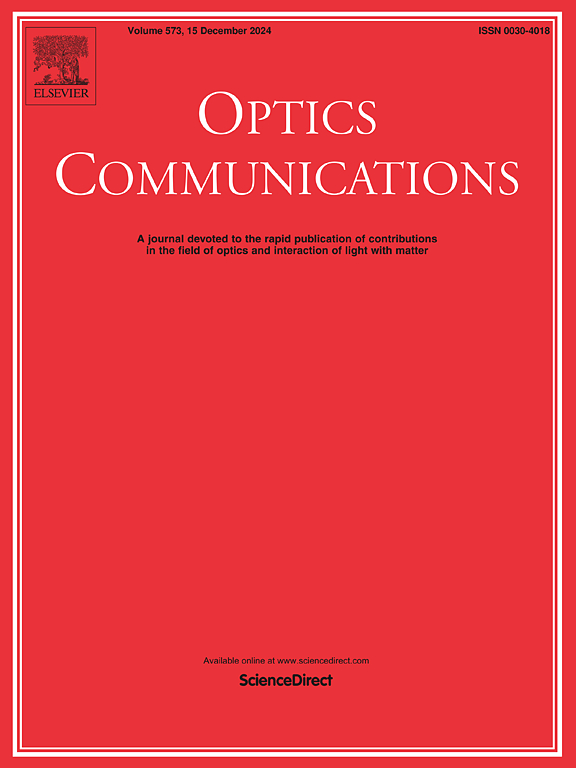Receiver-side LSBoost-Aided constellation denoising for energy-efficient VLC systems
IF 2.2
3区 物理与天体物理
Q2 OPTICS
引用次数: 0
Abstract
Low-resolution digital-to-analog converters (DACs) have emerged as promising components for visible light communication (VLC) systems, owing to their low power consumption and reduced hardware cost. However, ultra-low-resolution quantization introduces significant signal distortion and limits the achievable modulation formats, particularly in high-speed optical wireless links. In this work, we experimentally demonstrate a receiver-side Least Squares Boosting Constellation Denoiser (LSBCD) designed for asymmetrically clipped optical orthogonal frequency division multiplexing (ACO-OFDM) VLC systems utilizing low-resolution DACs over a 1-m free-space optical (FSO) link. With standard round-off (RO) quantization, the baseline system supports at most 32-QAM at 4-bit resolution and fails to reach the hard-decision forward error correction (HD-FEC) threshold at 3-bit resolution. While transmitter-side digital resolution enhancer (DRE) techniques can reduce quantization noise and enable higher-order modulation formats (such as 64-QAM at 4-bit), they require additional hardware complexity and transmitter modifications. By contrast, the proposed LSBCD module at the receiver is designed to achieve comparable performance gains with significantly lower computational and implementation complexity. At a symbol rate of 0.75 GBaud, our experimental results show that LSBCD enables reliable 32-QAM transmission using a 3-bit DAC, reducing the bit error rate (BER) from 0.0108 to 0.0033. For 64-QAM with a 4-bit DAC, LSBCD further lowers the BER from 0.0072 to 0.0023, matching or surpassing DRE-based improvements. These findings validate that LSBCD is highly suitable for short-range VLC scenarios. Overall, our research offers a practical and energy-efficient pathway to improve performance in low-resolution OFDM-based VLC systems. The fully receiver-side, modular nature of LSBCD supports flexible integration into future large-scale VLC networks and IoT-oriented optical wireless communication systems, meeting the evolving requirements for cost, scalability, and adaptability in next-generation smart environments.
面向节能VLC系统的接收机侧lsboost辅助星座降噪
低分辨率数模转换器(dac)由于其低功耗和降低硬件成本而成为可见光通信(VLC)系统中有前途的组件。然而,超低分辨率量化引入了显著的信号失真并限制了可实现的调制格式,特别是在高速光学无线链路中。在这项工作中,我们通过实验展示了一种接收机侧最小二乘增强星座降噪器(LSBCD),该降噪器设计用于利用1米自由空间光(FSO)链路上的低分辨率dac的非对称裁剪光正交频分复用(ACO-OFDM) VLC系统。使用标准的四舍五入(RO)量化,基线系统在4位分辨率下最多支持32-QAM,而在3位分辨率下无法达到硬决策前向纠错(HD-FEC)阈值。虽然发送端数字分辨率增强(DRE)技术可以减少量化噪声并支持高阶调制格式(例如4位的64-QAM),但它们需要额外的硬件复杂性和发送端修改。相比之下,所提出的接收器上的LSBCD模块旨在以显着降低的计算和实现复杂性来实现类似的性能增益。在0.75 GBaud的符号速率下,我们的实验结果表明,LSBCD使用3位DAC实现可靠的32-QAM传输,将误码率(BER)从0.0108降低到0.0033。对于带有4位DAC的64-QAM, LSBCD进一步将误码率从0.0072降低到0.0023,与基于re的改进相匹配或超过。这些发现验证了LSBCD非常适合近距离VLC场景。总的来说,我们的研究为提高低分辨率ofdm VLC系统的性能提供了一条实用且节能的途径。LSBCD的完全接收端模块化特性支持灵活集成到未来的大规模VLC网络和面向物联网的光无线通信系统中,满足下一代智能环境中不断变化的成本、可扩展性和适应性要求。
本文章由计算机程序翻译,如有差异,请以英文原文为准。
求助全文
约1分钟内获得全文
求助全文
来源期刊

Optics Communications
物理-光学
CiteScore
5.10
自引率
8.30%
发文量
681
审稿时长
38 days
期刊介绍:
Optics Communications invites original and timely contributions containing new results in various fields of optics and photonics. The journal considers theoretical and experimental research in areas ranging from the fundamental properties of light to technological applications. Topics covered include classical and quantum optics, optical physics and light-matter interactions, lasers, imaging, guided-wave optics and optical information processing. Manuscripts should offer clear evidence of novelty and significance. Papers concentrating on mathematical and computational issues, with limited connection to optics, are not suitable for publication in the Journal. Similarly, small technical advances, or papers concerned only with engineering applications or issues of materials science fall outside the journal scope.
 求助内容:
求助内容: 应助结果提醒方式:
应助结果提醒方式:


